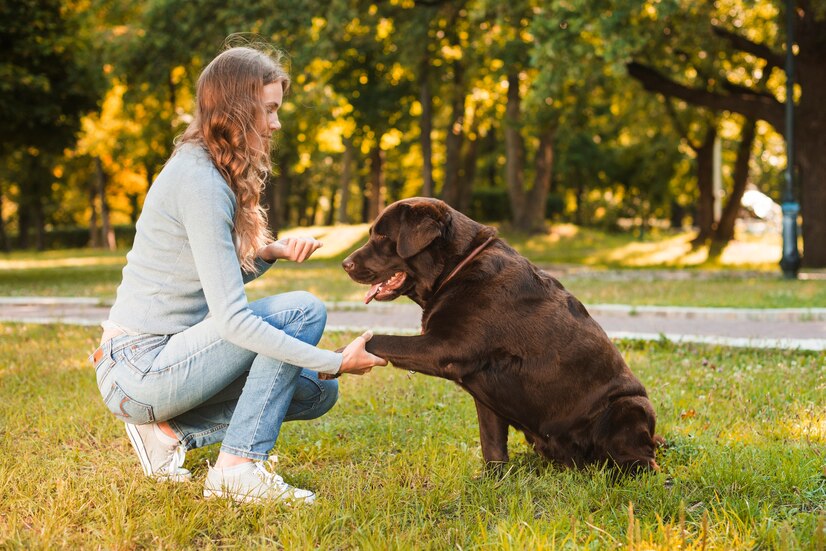Teaching your dog basic commands can be a fun and rewarding experience for you and your pup. Whether you’re getting a new puppy or need to refine some of its existing behaviour, training basic commands to your canine buddy is integral to having a well-mannered pet.
This will help them obey instructions more readily and increase safety near other people and animals. Obedience classes have been linked to enhanced socialisation in certain breeds! If you’ve been wondering how to teach basic commands to your pup, keep reading — we’ll cover the basics so even beginners can get up and running quickly.
Develop a Positive Training Environment
Creating a positive training environment for your furry friend can make all the difference. The key is to be patient and consistent with your methods, using positive reinforcement rather than punishment. This approach will allow your dog to learn at their own pace, free from the stress and anxiety of harsh training tactics. Regarding the concern about How Long is Dog Training Typically? There is no set time frame for how long it will take to train your dog.
It all depends on factors such as breed, age, and temperament. Whether it takes weeks, months, or even longer, you can rest assured that your dog will learn healthily and happily in a positive training environment.
Start with basic commands such as “sit” and “stay.”
These basic commands lay a foundation for your pup to understand more complex instructions. Plus, it’s a great way to establish trust and respect between you and your four-legged companion. Starting with something as simple as “sit” may seem mundane, but it can affect your pup’s behaviour and obedience. So grab some treats, get your pup’s attention, and practice those commands!
Reinforce the Commands with Treats and Praise
When training your dog, using treats and praise to reinforce commands is a great way to create a positive and enjoyable learning experience. Dogs are eager to please their owners, and offering them a tasty treat or a kind word can encourage them to repeat desired behaviours.
Whether you teach your pup to sit, stay, or come when called, consistent and enthusiastic rewards can help solidify their understanding of what you want them to do. And let’s face it, who doesn’t love being showered with treats and praise? With some time and patience, you’ll find that training your dog can be a fun bonding experience for both of you.

Break Down Complex Commands into Smaller Steps
When tackling complex tasks, like programming or building something from scratch, it’s easy to become overwhelmed by the number of steps involved. That’s why breaking those tasks into smaller, more manageable steps is crucial. This approach makes the task at hand less daunting and helps you identify potential issues before they become significant problems.
You can focus on each task by tackling the job one step at a time and building momentum towards the final goal. So, the next time you’re faced with a complex command, remember to break it down into bite-sized steps to make the process more manageable.
Create Opportunities to Practice the Commands in Everyday Situations
Learning a new language can be challenging, but it becomes much easier when you have opportunities to practice outside the classroom. One effective way to improve your language skills is to integrate the commands you learn into everyday situations.
For example, you can practice asking for directions when lost, ordering food in a restaurant, or even making small talk with strangers. Applying the language in real-life situations will reinforce what you’ve learned and gain confidence in your abilities. With everyday practice, you’ll see tangible progress that will keep you motivated as you continue improving your language skills.
Ensure Consistent Training Sessions with Regular Routines
Consistency is critical when it comes to training sessions. Whether working out or learning a new skill, establishing regular routines can help you achieve your goals effectively. By implementing a structured schedule for training, you can create a reliable foundation that fosters progress and development.
This consistency not only helps you to build the discipline required to succeed in your endeavours, but it also helps you to stay motivated by providing a sense of accomplishment as you reach milestones and complete tasks. So, whether it’s a daily yoga routine or a weekly career development workshop, committing to regular exercises is a great way to ensure you’re making the most of your time and efforts.

Final Thought
The key to creating a successful and enjoyable training experience is to develop a positive training environment and start with simple commands that can be reinforced with rewards. As you move forward, break down complex commands into smaller steps to make learning easier and create opportunities to practice the commands in everyday life. Last but not least, remember that consistency is the key to your pup’s learning process. Ensure consistent training sessions within regular routines, give your pet ample opportunity to practice new skills, and, above all else, show patience and understanding with their progress. With these tips in mind, you will be well on your way towards having a happy and well-behaved pup!




